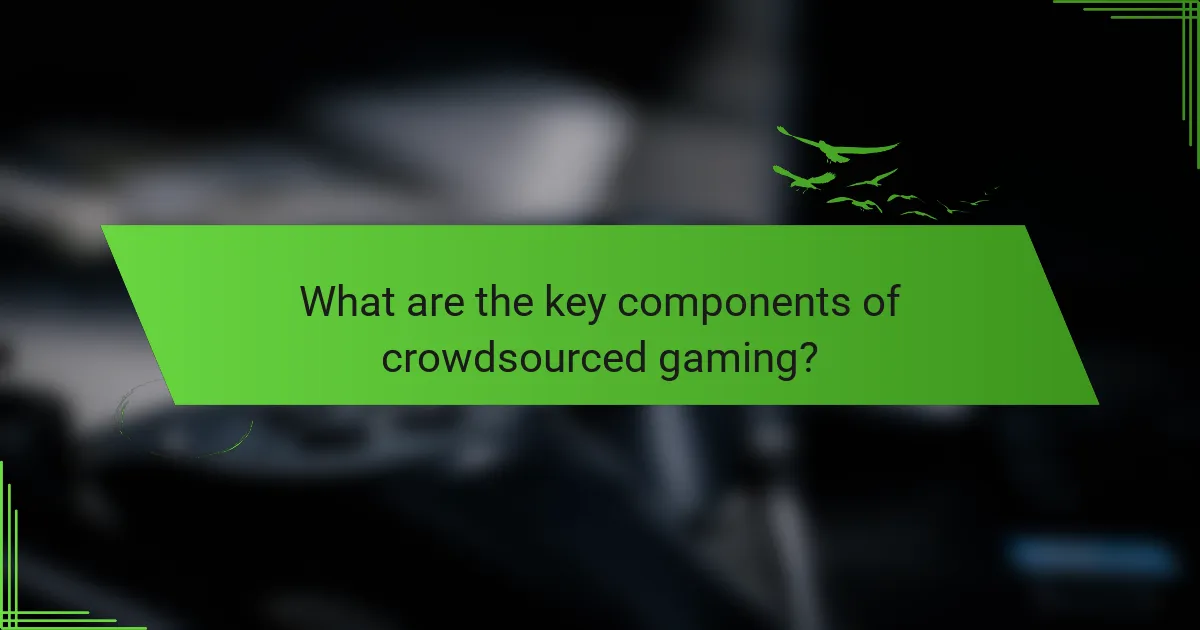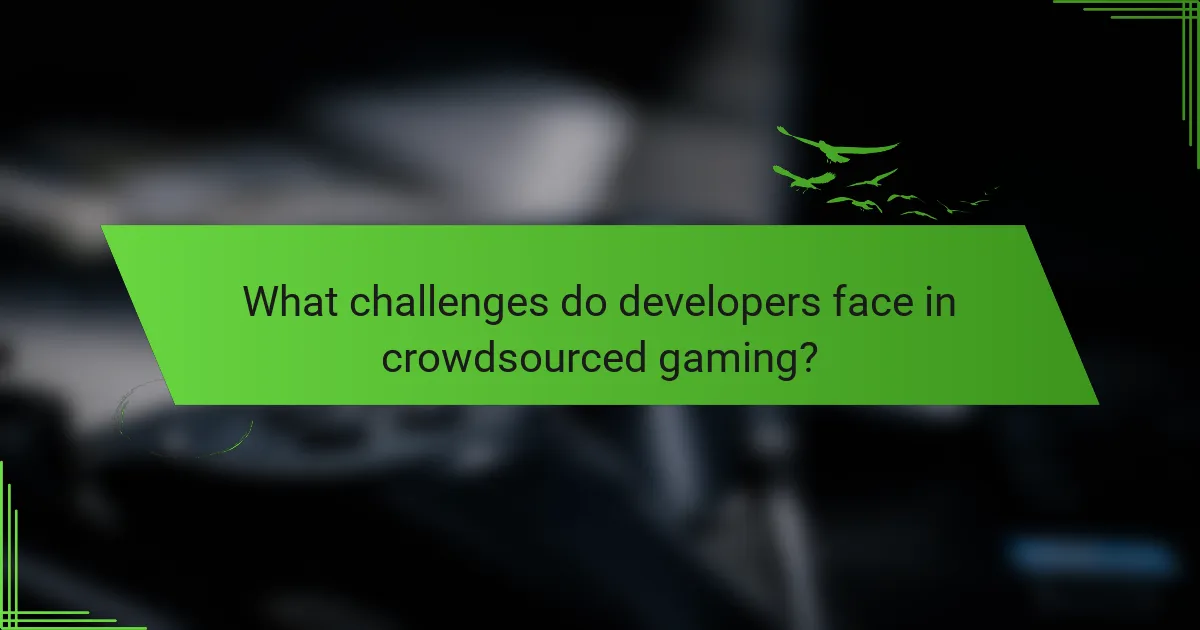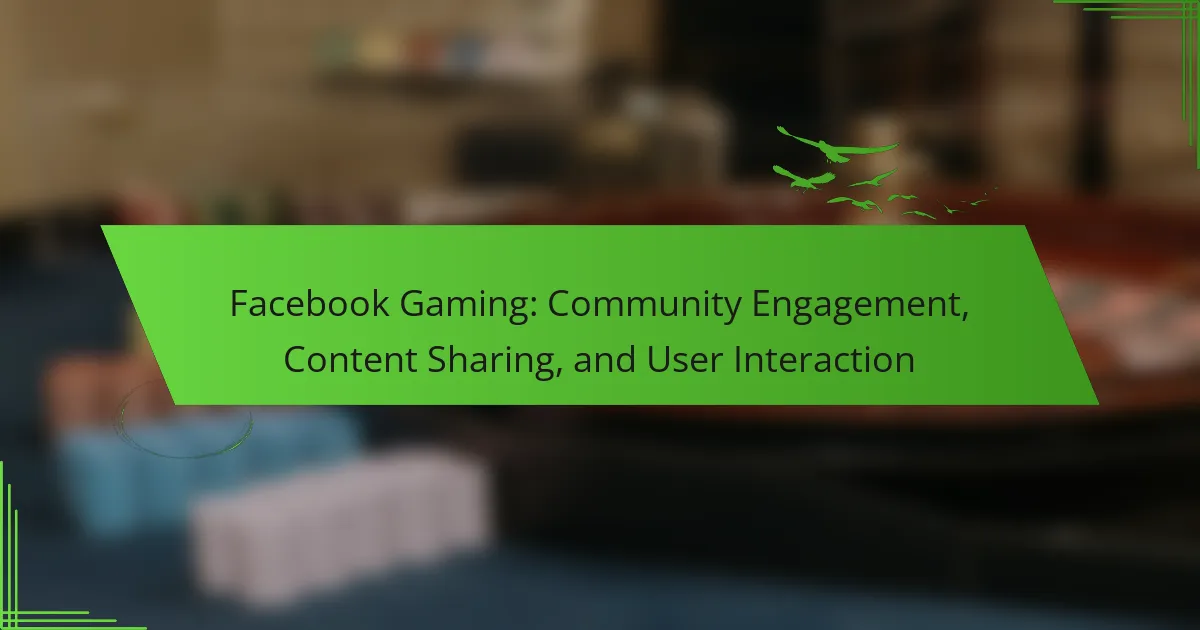Crowdsourced gaming enhances player engagement and innovation through community contributions and collaborative design. This model leverages player-generated content, fosters active participation, and analyzes impact to improve user experiences. Developers face challenges in quality control and resource management while adapting engagement strategies to maintain community involvement. The future of crowdsourced gaming will focus on community-driven content, advanced analytics, and evolving interaction methods.

What are the key components of crowdsourced gaming?
Crowdsourced gaming relies on community contributions, engagement strategies, and impact analysis. Key components include player-generated content, collaborative game design, and community feedback mechanisms. These elements enhance user engagement and foster a sense of ownership among players. Additionally, analyzing the impact of these contributions helps developers refine gameplay and improve player experiences.
How do community contributions shape game development?
Community contributions significantly shape game development by enhancing creativity, fostering player engagement, and providing valuable feedback. Crowdsourced input leads to innovative ideas that developers may overlook. This collaborative approach allows players to feel invested in the game’s evolution, increasing loyalty and community support. Additionally, developers gain insights into player preferences, which can guide future updates and expansions.
What role does player feedback play in game design?
Player feedback is crucial in game design as it shapes gameplay, enhances user experience, and fosters community engagement. By integrating player insights, developers can identify strengths and weaknesses in their games. This process leads to iterative improvements, ensuring the game evolves based on actual player experiences. Engaging with the community also builds loyalty, encouraging players to invest more time and resources into the game. Ultimately, effective feedback mechanisms can drive a game’s success by aligning development with player expectations and preferences.
Which platforms facilitate crowdsourced gaming experiences?
Several platforms facilitate crowdsourced gaming experiences, enabling community contributions and engagement. Notable examples include Steam, Roblox, and itch.io. These platforms allow users to create, share, and monetize their gaming content, fostering collaboration and innovation within gaming communities. Additionally, platforms like Discord enhance community interaction and support for game development through feedback and ideas.

How do engagement strategies enhance player participation?
Engagement strategies significantly enhance player participation by fostering community involvement and collaboration. These strategies encourage players to contribute ideas and content, creating a sense of ownership. As a result, players feel more connected to the game, leading to increased retention and active participation. Crowdsourced gaming thrives on this dynamic, as community contributions enrich the gameplay experience. Engaging players through feedback loops and rewards further amplifies their investment, ultimately driving sustained interest and participation.
What incentives drive community involvement in gaming projects?
Community involvement in gaming projects is driven by incentives such as social connection, recognition, and potential rewards. Participants often seek to collaborate with others who share their interests, creating a sense of belonging. Recognition from developers and peers enhances engagement, motivating contributors to share their skills and ideas. Additionally, tangible rewards, like in-game items or monetary compensation, can further incentivize participation. These factors collectively cultivate a vibrant community that actively contributes to the gaming ecosystem.
How can developers leverage social media for engagement?
Developers can leverage social media to enhance engagement by fostering community interaction and feedback. Utilizing platforms like Twitter and Discord allows developers to share updates, gather player insights, and create a sense of belonging. Engaging content, such as polls and live streams, encourages active participation. Additionally, developers can showcase user-generated content, reinforcing community contributions. This approach not only builds loyalty but also informs future game development, aligning with player expectations.
Which gamification techniques boost user interaction?
Crowdsourced gaming techniques that boost user interaction include collaborative challenges, community leaderboards, and user-generated content. These strategies enhance engagement by fostering a sense of belonging and competition. Collaborative challenges encourage teamwork, while leaderboards provide recognition. User-generated content allows players to contribute creatively, enriching the gaming experience.

What impact does crowdsourced gaming have on the industry?
Crowdsourced gaming significantly enhances community engagement and innovation in the gaming industry. It fosters collaboration among players, leading to diverse game development and improved user experiences. This model allows developers to tap into a vast pool of ideas and talent, increasing creativity and reducing costs. As a result, crowdsourced gaming can lead to more dynamic and responsive game environments, ultimately benefiting both developers and players.
How do community-driven projects influence market trends?
Community-driven projects significantly influence market trends by fostering engagement and innovation. Crowdsourced gaming leverages community contributions to shape game development, enhancing player experience and market adaptability.
Engagement strategies, such as feedback loops and beta testing, allow developers to align their products with player preferences. This direct input often leads to unique gaming features that resonate with audiences, driving sales and creating trends.
Additionally, community-driven initiatives can create a sense of ownership among players. This emotional investment not only boosts loyalty but also encourages word-of-mouth marketing, which can rapidly shift market dynamics.
As a result, the impact analysis of these projects reveals a clear correlation between community involvement and market responsiveness, illustrating how player-driven insights can dictate industry direction.
What are the economic benefits of crowdsourced gaming?
Crowdsourced gaming offers significant economic benefits, including cost savings, increased revenue, and community engagement. By leveraging community contributions, developers reduce development costs and enhance game quality. This collaborative model fosters player loyalty, leading to higher long-term revenue. Additionally, crowdsourced gaming can create job opportunities within the community, stimulating local economies. As a result, the economic impact extends beyond individual games, benefiting the broader gaming industry.
How does player collaboration affect game longevity?
Player collaboration significantly enhances game longevity by fostering community engagement and shared experiences. Collaborative gameplay creates a sense of belonging, encouraging players to invest more time and effort. This engagement can lead to sustained interest in the game, as players feel their contributions matter. Additionally, community-driven content, such as mods or user-generated levels, can extend a game’s life cycle by introducing fresh challenges and experiences. As a result, games with strong collaborative elements often enjoy longer active player bases and higher retention rates.

What challenges do developers face in crowdsourced gaming?
Developers face several challenges in crowdsourced gaming, including quality control, community engagement, and resource management. Ensuring consistent quality of contributions is difficult due to varying skill levels among participants. Engaging the community effectively requires ongoing communication and motivation strategies. Additionally, developers must manage limited resources while balancing game development and community input. These challenges can impact game performance and player satisfaction.
How can issues of quality control be managed?
Quality control in crowdsourced gaming can be effectively managed through community engagement, clear guidelines, and ongoing feedback. Establishing a robust framework allows players to contribute while ensuring standards are met. Regular updates and communication foster a sense of ownership and accountability among contributors. Implementing metrics to assess contributions enhances the quality of input and identifies areas for improvement.
What legal considerations must be addressed?
Crowdsourced gaming involves several legal considerations, including intellectual property rights, user agreements, and data privacy. Ensuring compliance with copyright laws is crucial, as community contributions may include original content. User agreements must clearly outline rights and responsibilities, protecting both the platform and contributors. Data privacy regulations, such as GDPR, should be addressed to safeguard user information. Additionally, liability issues may arise from user-generated content, necessitating careful management of community interactions and moderation strategies.
How do cultural differences impact gaming communities?
Cultural differences significantly shape gaming communities by influencing player interactions and engagement strategies. Diverse cultural backgrounds bring unique perspectives, affecting communication styles and gameplay preferences.
For example, community contributions may vary based on cultural values, leading to different approaches in collaborative projects. Engagement strategies must adapt to these cultural nuances to foster inclusivity and enhance player experiences.
As a result, understanding these cultural dynamics can improve community cohesion and participation, ultimately benefiting the overall gaming environment.

What are the future trends in crowdsourced gaming?
Crowdsourced gaming will increasingly rely on community-driven content, enhanced engagement strategies, and advanced analytics. Gamers will contribute more to game design, shaping narratives and gameplay through feedback and creative input. Engagement strategies will evolve, utilizing social media and live-streaming platforms to foster community interaction. Additionally, data analytics will assess player behavior, driving personalized experiences and optimizing game development. This trend will enhance player satisfaction and retention, creating a more dynamic gaming ecosystem.
How is technology evolving to support community contributions?
Technology is evolving to enhance community contributions in crowdsourced gaming through improved platforms and engagement tools. Innovations like real-time collaboration features allow players to create content collectively. Advanced analytics track community impact, enabling developers to refine engagement strategies. Additionally, gamification elements encourage participation by rewarding contributions, fostering a sense of ownership and belonging among players. This evolution not only enhances user experience but also drives game development through valuable community insights.
What innovations are emerging in player-driven content creation?
Emerging innovations in player-driven content creation include enhanced community tools, user-generated assets, and collaborative platforms. These innovations foster deeper engagement and allow players to influence game development directly. For example, platforms like Roblox and Fortnite enable players to create and share their own game experiences, generating unique content. Additionally, advancements in AI assist in streamlining content creation, making it more accessible for non-developers. As a result, player contributions significantly impact game dynamics and community cohesion.
Which upcoming platforms are set to revolutionize crowdsourced gaming?
Several upcoming platforms are poised to transform crowdsourced gaming through innovative community engagement and contribution models. Platforms like Figment, Gamefound, and Crowdplay focus on integrating player feedback and collaborative game development. These platforms emphasize user-generated content, enabling players to shape game narratives and mechanics. As a result, they cultivate deeper connections between developers and communities, enhancing user experience and fostering loyalty. The unique attribute of these platforms lies in their ability to leverage real-time collaboration, allowing players to contribute actively during the game’s lifecycle.
What best practices can enhance crowdsourced gaming initiatives?
Crowdsourced gaming initiatives can enhance community contributions and engagement through targeted strategies. Encouraging active participation fosters a sense of ownership among players. Providing clear guidelines and feedback loops enhances collaboration and motivation. Utilizing social media platforms increases visibility and interaction, attracting diverse contributors. Implementing reward systems recognizes contributions, driving further engagement. Regularly analyzing community feedback helps refine strategies and improve overall impact.



